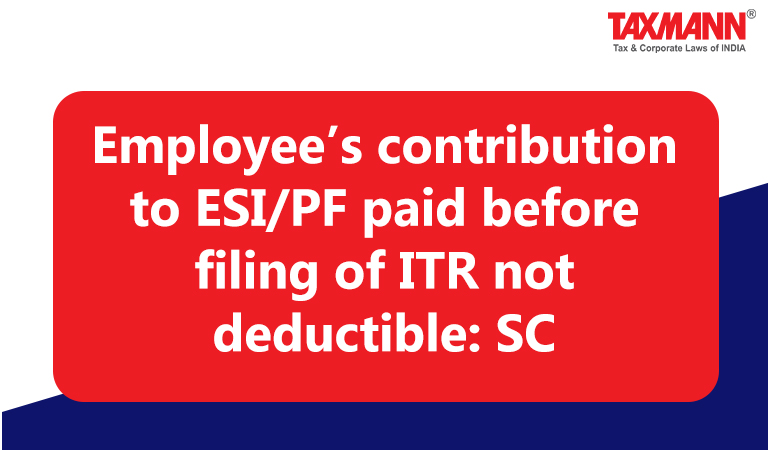Employee’s contribution to ESI/PF paid before filing of ITR not deductible: SC
- Blog|News|Income Tax|
- 2 Min Read
- By Taxmann
- |
- Last Updated on 15 October, 2022
Case Details: Checkmate Services (P.) Ltd. v. CIT - [2022] 143 taxmann.com 178 (SC)
Judiciary and Counsel Details
-
- Uday Umesh Lalit, CJI, S. Ravindra Bhat & Sudhanshu Dhulia, JJ.
Facts of the Case
The issue before the Supreme Court was with respect to the interpretation of Section 36(1)(va) and Section 43B. Whether deposit of employee’s contribution towards the EPF and ESI after the expiry of the due date under the relevant acts eligible for the deduction?
Supreme Court Held
The Supreme Court of India held that the Parliament treated contributions under Section 36(1)(va) differently from those under Section 36(1)(iv). The latter is described as
“sum paid by the assessee as an employer by way of contribution towards a recognized provident fund”.
However, the phraseology of Section 36(1)(va) differs from Section 36(1)(iv). It enacts that
“any sum received by the assessee from any of his employees to which the provisions of section 2(24)(x) apply if such sum is credited by the assessee to the employee’s account in the relevant fund or funds on or before the due date.”
These establish that Parliament while introducing Section 36(1)(va) along with Section 2(24)(x), was aware of the distinction between the two types of contributions. There was a statutory classification, under the IT Act, between the two.
The essential character of an employee’s contribution, i.e., that it is part of the employee’s income, held in trust by the employer is underlined by the condition that it has to be deposited on or before the due date.
Amounts retained by the employer from out of the employee’s income by way of deduction etc. were treated as income in the hands of the employer. The significance of this provision is that on the one hand, it brought into the fold of “income”; at the time, payment within the prescribed time is to be treated as a deduction (Section 36(1)(va)).
The other important feature is that this distinction between the employers’ contribution (Section 36(1)(iv)) and employees’ contribution required to be deposited by the employer (Section 36(1)(va)) was maintained and continues to be maintained.
Since there is a marked distinction between the nature and character of the two amounts – the employer’s liability is to be paid out of its income whereas the second is deemed an income, this marked distinction has to be borne while interpreting the obligation of every assessee under Section 43B.
Accordingly, the benefit of section 43B can’t be made available for the employee’s contribution deposited before the filing of the Income-tax Return.
Disclaimer: The content/information published on the website is only for general information of the user and shall not be construed as legal advice. While the Taxmann has exercised reasonable efforts to ensure the veracity of information/content published, Taxmann shall be under no liability in any manner whatsoever for incorrect information, if any.

Taxmann Publications has a dedicated in-house Research & Editorial Team. This team consists of a team of Chartered Accountants, Company Secretaries, and Lawyers. This team works under the guidance and supervision of editor-in-chief Mr Rakesh Bhargava.
The Research and Editorial Team is responsible for developing reliable and accurate content for the readers. The team follows the six-sigma approach to achieve the benchmark of zero error in its publications and research platforms. The team ensures that the following publication guidelines are thoroughly followed while developing the content:
- The statutory material is obtained only from the authorized and reliable sources
- All the latest developments in the judicial and legislative fields are covered
- Prepare the analytical write-ups on current, controversial, and important issues to help the readers to understand the concept and its implications
- Every content published by Taxmann is complete, accurate and lucid
- All evidence-based statements are supported with proper reference to Section, Circular No., Notification No. or citations
- The golden rules of grammar, style and consistency are thoroughly followed
- Font and size that’s easy to read and remain consistent across all imprint and digital publications are applied








 CA | CS | CMA
CA | CS | CMA


